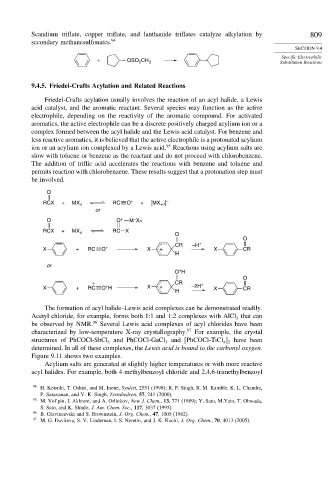Page 826 - Advanced Organic Chemistry Part A - Structure and Mechanisms, 5th ed (2007) - Carey _ Sundberg
P. 826
Scandium triflate, copper triflate, and lanthanide triflates catalyze alkylation by 809
secondary methanesulfonates. 94
SECTION 9.4
Specific Electrophilic
+ OSO CH 3 Substitution Reactions
2
9.4.5. Friedel-Crafts Acylation and Related Reactions
Friedel-Crafts acylation usually involves the reaction of an acyl halide, a Lewis
acid catalyst, and the aromatic reactant. Several species may function as the active
electrophile, depending on the reactivity of the aromatic compound. For activated
aromatics, the active electrophile can be a discrete positively charged acylium ion or a
complex formed between the acyl halide and the Lewis acid catalyst. For benzene and
less reactive aromatics, it is believed that the active electrophile is a protonated acylium
95
ion or an acylium ion complexed by a Lewis acid. Reactions using acylium salts are
slow with toluene or benzene as the reactant and do not proceed with chlorobenzene.
The addition of triflic acid accelerates the reactions with benzene and toluene and
permits reaction with chlorobenzene. These results suggest that a protonation step must
be involved.
O
RCX + MX n RC O + + [MX ] –
+1
or
–
O O + M Xn
RCX + MX n RC X O
O
CR –H +
X + RC O + X + X CR
H
or
+
O H
O
+ CR +
+
X + RC O H X + –2H X CR
H
The formation of acyl halide–Lewis acid complexes can be demonstrated readily.
Acetyl chloride, for example, forms both 1:1 and 1:2 complexes with AlCl that can
3
be observed by NMR. 96 Several Lewis acid complexes of acyl chlorides have been
characterized by low-temperature X-ray crystallography. 97 For example, the crystal
structures of PhCOCl-SbCl and PhCOCl-GaCl and [PhCOCl-TiCl ] have been
3
4 2
5
determined. In all of these complexes, the Lewis acid is bound to the carbonyl oxygen.
Figure 9.11 shows two examples.
Acylium salts are generated at slightly higher temperatures or with more reactive
acyl halides. For example, both 4-methylbenzoyl chloride and 2,4,6-trimethylbenzoyl
94
H. Kotsuki, T. Oshisi, and M. Inoue, Synlett, 2551 (1998); R. P. Singh, R. M. Kamble, K. L. Chandra,
P. Saravanan, and V. K. Singh, Tetrahedron, 57, 241 (2000).
95 M. Vol’pin, I. Akhrem, and A. Orlinkov, New J. Chem., 13, 771 (1989); Y. Sato, M.Yato, T. Ohwada,
S. Sato, and K. Shudo, J. Am. Chem. Soc., 117, 3037 (1995).
96 B. Glavincevski and S. Brownstein, J. Org. Chem., 47, 1005 (1982).
97
M. G. Davlieva, S. V. Lindeman, I. S. Neretin, and J. K. Kochi, J. Org. Chem., 70, 4013 (2005).

